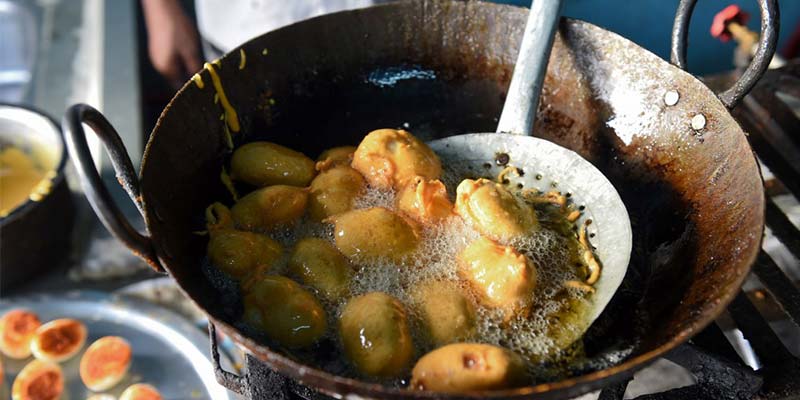- India
- Jan 04
FSSAI caps maximum limit of trans fats in oils to 3%
• The Food Safety and Standards Authority of India (FSSAI) has notified that the maximum limit of trans fatty acids in oils and fats shall not be more than 3 per cent by weight from January 1, 2021 and not more than 2 per cent by weight from January 1, 2022. The earlier permissible limit was 5 per cent.
• Intake of trans fatty acids (TFA) is associated with increased risk of heart attacks and death from coronary heart disease. Trans fat intake is responsible for approximately five lakh premature deaths from coronary heart disease each year around the world.
• Replacing industrially produced TFA with healthier oils and fats is cost-effective and feasible, and can be done without changing the taste of food or its cost to the consumer.
What are trans fats?
• Industrial trans fats are made by adding hydrogen to liquid vegetable oils to make them more solid, and to increase the shelf life of foods. Trans fats are largely present in partially hydrogenated vegetable fats/oils, vanaspati, margarine and bakery shortenings (used in preparation of bakery products), and can be found in baked and fried foods.
• Industrial trans fats are toxic compounds that are the cause of cardiovascular and other related diseases.
• India is committed to eliminate trans fats from the food supply and is progressing towards its objective of trans fat elimination in a phased manner.
• In October 2019, Union Health Minister Harsh Vardhan launched the ‘trans fat free’ logo, which can be voluntarily used by food business operators in their outlets and also on food products. Food establishments which use trans fat free fats/oil and do not have industrial trans fat more than 0.2g/100g of food, in compliance with the Food Safety and Standards (Advertising and Claims) Regulations, 2018 can display ‘trans fat free’ logo in their outlets and on their food products.
• Trans fat is a major contributor to the rise in non-communicable diseases in India. It is a modifiable risk factor for cardiovascular diseases (CVD).
Food Safety and Standards Authority of India (FSSAI)
• The Food Safety and Standards Authority of India (FSSAI) has been established under Food Safety and Standards Act, 2006 which consolidates various Acts and orders that have hitherto handled food related issues in various ministries and departments.
• FSSAI was created for laying down scientific standards for food articles and to regulate their manufacture, storage, distribution, sale and import to ensure availability of safe and wholesome food for human consumption.
• The ministry of health and family welfare is the administrative ministry for the implementation of FSSAI.
The main functions of FSSAI include:
• Setting globally benchmarked regulations, standards and guidelines.
• Facilitating compliance through licensing, registration, inspection and improved laboratory network.
• Building capacity of regulatory staff as well as food business operators.
• Driving public health initiatives in the true spirit of convergence.
• Leveraging IEC (Information, Education & Communication) and BCC (behaviour change communication) techniques to build a food safety culture.
• Embracing technology to streamline processes.
• Forging strategic partnerships to generate and exchange knowledge and best practices.
Eat Right India movement
• In the preamble to the Food Safety and Standards Act, 2006, the Food Safety and Standards Authority of India (FSSAI) is expected to ensure availability of safe and wholesome food for the people in India.
• To improve public health in India and combat negative nutritional trends to fight lifestyle diseases, the FSSAI launched Eat Right India movement on July 10, 2018.
• The focus of the movement is on improving the health and well-being of people by ensuring they eat healthy.
• The Eat Right India Movement is built on the two broad pillars of ‘Eat Healthy’ and ‘Eat Safe’. It aims to engage, excite and enable citizens to improve their health and well-being.
• The strength of the movement lies in its holistic and collaborative approach, with stakeholders on both the demand and supply-side joining to make a difference through some clearly identified steps.
• On the demand side, the movement focuses on empowering citizens to make the right food choices. On the supply side, it nudges food businesses to reformulate their products, provide better nutritional information to consumers and make investments in healthy food as responsible food businesses.
WHO’s REPLACE action framework
• In May 2018, the World Health Organisation (WHO) called for the global elimination of industrially produced TFA by 2023 and released the REPLACE action framework.
• In May 2019, WHO released six REPLACE modules, which provide practical, step-by-step implementation guidance to support governments. WHO recommends that countries adopt and implement one of two best-practice policy options for eliminating industrially produced TFA from the food supply.
The six areas of action include:
• Review dietary sources of industrially-produced trans fat and the landscape for required policy change.
• Promote the replacement of industrially-produced trans fat with healthier fats and oils.
• Legislate or enact regulatory actions to eliminate industrially-produced trans fat.
• Assess and monitor trans fat content in the food supply and changes in trans fat consumption in the population.
• Create awareness of the negative health impact of trans fat among policy-makers, producers, suppliers, and the public.
• Enforce compliance with policies and regulations.
As many as 58 countries so far have introduced laws that will protect 3.2 billion people from the harmful substance by the end of 2021. But more than 100 countries still need to take actions to remove these harmful substances from their food supplies.
Manorama Yearbook app is now available on Google Play Store and iOS App Store


